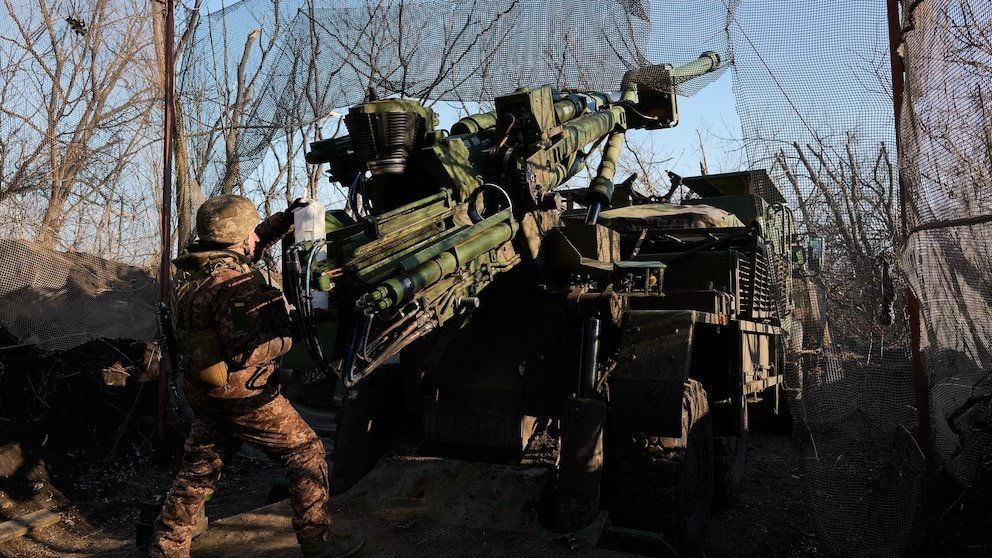
What the potential outcomes of ending the Ukraine-Russia war might look like
Talks kicked off this week in a United States-led effort to end the war in Ukraine, nearly three years after Russia invaded its neighbor.
The U.S. and Russia agreed to start talks to try to negotiate a settlement to end the war during their high-level meeting in Saudi Arabia, which notably did not have any Ukrainian or European participation.
Following this week’s talks between the U.S. and Russia, President Donald Trump warned Ukrainian President Volodymyr Zelenskyy to quickly negotiate the war’s end or “he is not going to have a country left.”
The discussions marked the first high-level talks between Russia and the U.S. in nearly three years, since the beginning of the war. The last sit-down meeting between Russian Foreign Minister Sergey Lavrov and former U.S. Secretary of State Anthony Blinken took place in Geneva, Switzerland, on Jan. 21, 2022. The two were set to meet again days before Russia invaded Ukraine on Feb. 24, 2022, but their meeting was canceled. Their next communication was more than a year later, on March 2, 2023, during the summit of the Group of 20 Foreign Ministers in New Delhi, India.
The high-stakes talks mark an “extraordinary time in history,” ABC News contributor and retired Marine Col. Steve Ganyard said.
“The U.S. relationship with Europe is changing,” he said. “It’s a change that’s been underway for a long time. The U.S. has warned Europe, really going back as far as the Eisenhower administration, that they expected Europe to step up and be more of a leader in Europe, to spend more on their own defense. And finally, you have a president who said enough is enough.”
“Now, whether that’s a good thing or not, history will decide,” he continued. “But for now, the relationship with Europe is strained to the point of almost breaking. And the U.S. has gone on a unilateral discussion with Russia to determine the fate of Ukraine.”
The U.S.-Russia talks also were a step toward thawing relationships with Russia, signaling a huge shift in U.S. foreign policy. Secretary of State Marco Rubio, who attended the meeting, announced a tangible step to demonstrate the warming relationship between the United States and Russia — saying that both countries had agreed to staff up their respective missions in Washington and Moscow after a decade of tit-for-tat diplomatic expulsions had left the embassies running on skeleton crews.
Ukraine in ‘uncomfortable’ position
Before the talks even began, Defense Secretary Pete Hegseth said at a meeting of the Ukraine Defense Contact Group last week that Ukraine’s demand for full territorial liberation “is an unrealistic objective.” NATO membership for Ukraine, another goal of Zelenskyy’s, is also not seen by the U.S. as a “realistic outcome of a negotiated settlement,” he said, in another huge shift in U.S. foreign policy from the Biden administration.
Zelenskyy has vowed that his country would not sign any deal agreed to without its input. He also pushed back against a proposed deal that would give the U.S. half of the revenue from some of Ukraine’s key resources, including minerals, oil, gas and ports, as apparent payback for the American aid already rendered. A new version of the deal between the two countries has been put on the table, a U.S. official with knowledge of the negotiations said Thursday.
Ukraine has been put in an “uncomfortable” position with these bilateral talks, Ganyard said.
“They see that the U.S. may be determining their fate, and that fate right now seems to be a choice between bad and worse,” according to Ganyard.
The “bad” would be an agreement where Ukraine gives the U.S. access to its minerals, meaning a non-military “footprint” of the U.S. in Ukraine, “which you would think would be a deterrent to the Russians,” he said.
The “worse” would be the U.S. giving in to any demands from Russia to improve the relationship between D.C. and the Kremlin, “which seems to be a key tenet of the Trump administration,” Ganyard said.
At this stage, the best the Ukrainians may expect is to maintain about 80% of their pre-war territory, with Russia taking what they have seized so far since their invasion, according to Ganyard.
“There will be some other guarantees, no doubt that the U.S. will not allow Ukraine to join NATO. And who knows what else the Russians will be able to negotiate from the U.S.,” he said.
Europe being sidelined in Trump’s unilateral peace initiative will also have an impact on what a settlement looks like. Ukraine is waiting for Europe to step up and “at least give them some negotiating backing,” Ganyard said, adding, “Right now, that doesn’t seem to be apparent.”
“The best that the Ukrainians can hope for, at this time, if nothing else changes, is a settlement that is handed to them and is sort of a fait accompli that they will have to abide by,” Ganyard said. “And that will mean loss of territory, it means that they will have some sort of demilitarized area along their border with Russia. But it’s certainly better than Russian troops coming in again and going all the way to Kyiv.”
Europe would also need to provide the aircraft and the personnel on the ground to make any kind of a peace agreement work, he said. Zelenskyy has repeatedly said he will not sign an agreement without security guarantees.
UK Prime Minister Keir Starmer said he’d be willing to send troops to Ukraine as part of a possible agreement in an op-ed last week ahead of an emergency meeting of European leaders in Paris, and French President Emmanuel Macron, who’s been leading a European effort to respond to Trump’s changing foreign policy, plans to meet with Trump in Washington, D.C., next week.
A Western official told ABC News that Washington sent a questionnaire to European capitals asking about the capabilities each country could provide for Kyiv as part of a security guarantee for Ukraine. Reuters first reported that the U.S. sent the questionnaire before European leaders met at the emergency meeting in Paris on Monday to discuss a potential peacekeeping force.
Against the backdrop of the talks, the war goes on, with Ukraine continuing to fight off Russian strikes. Both Russia and Ukraine have suffered extensive casualties in the war and need a pause, Ganyard said.
“Neither has the manpower to be able to continue the war in the way that it has for years to come,” he said.
Ukraine has been using drones “to great advantage” but is still outnumbered by Russia and is dependent on Western support. The Trump administration has not sought new congressional funding for military assistance for Kyiv. House Speaker Mike Johnson said Thursday that there is “no appetite” for another funding bill for Ukraine.
“The Ukrainians are a bit desperate here,” Ganyard said. “They know that without U.S. military support, that their future is limited. Which is why they probably feel quite vulnerable knowing that the Europeans are not going to step in and do the kinds of things that the U.S. has been doing so that they, the Ukrainians, will be able to create some sort of negotiated peace on more favorable terms.”
War of words
A fierce back and forth between Trump and Zelenskyy ensued after the Ukrainian leader refused to sign the U.S.’ initial mineral resource deal and was not invited to the U.S.-Russia talks. Trump called Zelenskyy a “dictator” and falsely claimed that his Ukrainian counterpart’s public approval rating was as low as 4%. Zelenskyy countered that Trump is in a “disinformation space,” attributing at least some of the U.S. leader’s criticism to Russian disinformation campaigns.
Trump has gotten significant pushback from European leaders for his war on words questioning Zelenskyy’s legitimacy, with German Chancellor Olaf Scholz saying they were “simply wrong and dangerous.”
What is being said at the White House level “shouldn’t be discounted,” Ganyard said, but he noted the discussions themselves are likely to be “calmer” and “more reasonable.”
“Chaos reigns, and it’s obviously a negotiating tactic that the president likes to use,” Ganyard said. But he said there’s “always been a difference in a Trump presidency between what you hear at the White House level, between what the president says, what gets tweeted, and actually gets done.”
“Oftentimes, the bark is much harsher than the bite is,” he said.
Amid the nascent peace talks, Zelenskyy met with retired U.S. Lt. Gen. Keith Kellogg, the U.S. special envoy to Ukraine and Russia, on Thursday. Zelenskyy said the two had a “good conversation” and that he was “grateful to the United States for all the assistance and bipartisan support.”
Kellogg, for his part, called Zelenskyy an “embattled and courageous leader of a nation at war” and referred to the discussions with the Ukrainian leader as “extensive and positive.”
#UkrainePeace
#WarEndings
#ConflictOutcomes



